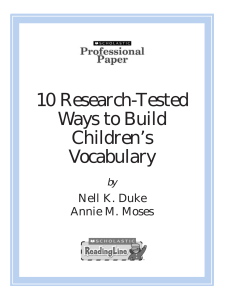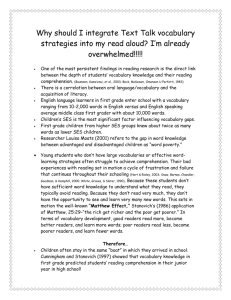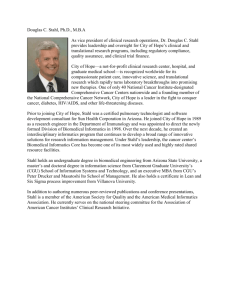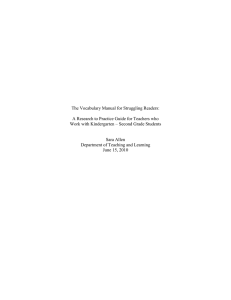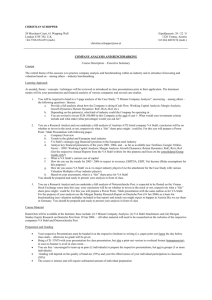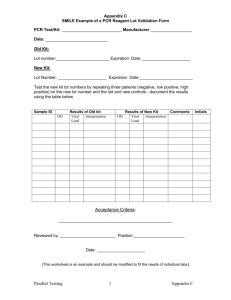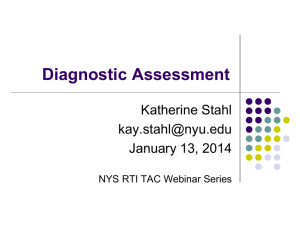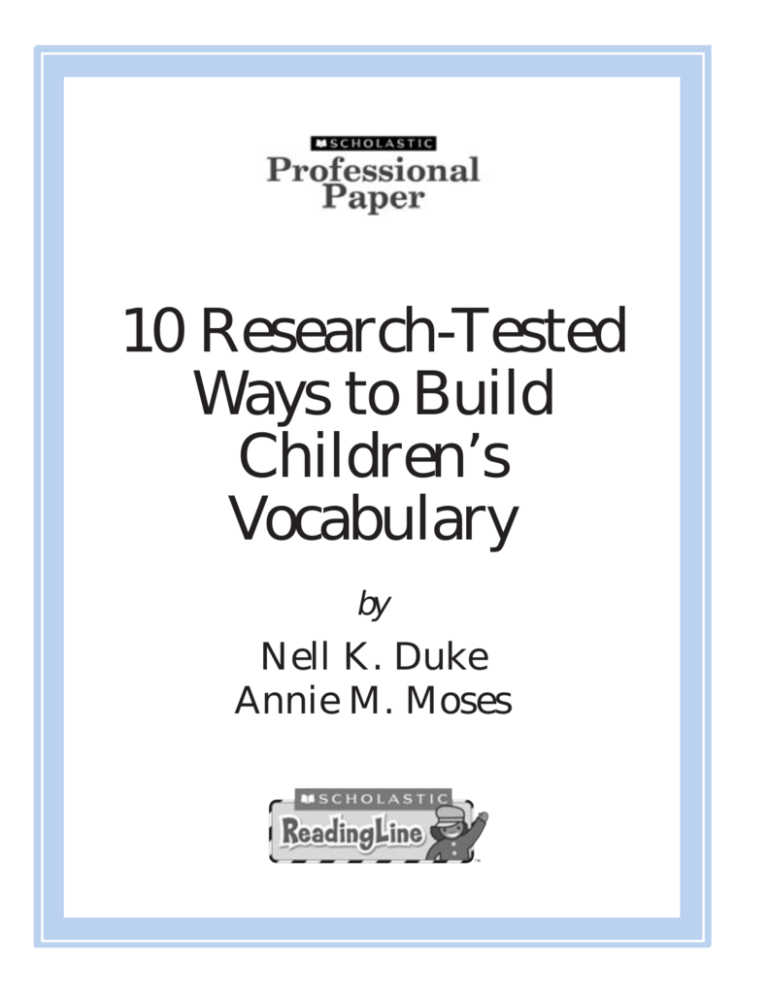
10 Research-Tested
Ways to Build
Children’s
Vocabulary
by
Nell K. Duke
Annie M. Moses
2
E
ach year the International Reading Association surveys literacy leaders from
around the world regarding “what’s hot” and “what’s not” in literacy (e.g.,
Cassidy and Cassidy, 2001/2002; 2002/2003). Year after year vocabulary has
been rated “not hot.” Yet over 75% of those surveyed think it “should be hot” (ibid.).
We agree, and the fact that you are reading this means that you probably do, too.
Research suggests that vocabulary is enormously important to children’s development,
especially in reading. Research clearly indicates that children with larger vocabularies
have higher school achievement in general (Smith, 1941, cited in Beck, McKeown, and
Kucan, 2002) and higher reading achievement in particular (Anderson and Freebody,
1981; Graves, 1986; Stahl, 1998). In fact, people with larger vocabularies even have
higher IQs (Bell, Lassiter, Matthews, and Hutchinson, 2001; Hodapp, and Gerken, 1999)!
Fortunately, a child’s vocabulary is not predestined. Rather, teachers can have a real
impact on children’s vocabulary knowledge. Research shows that teachers can do things
that significantly increase children’s vocabularies (Baumann, Kame’enui, and Ash, 2003;
Blachowicz and Fisher, 2000; National Reading Panel, 2000; Stahl and Fairbanks,
1986), and by doing so children’s reading comprehension will also improve (National
Reading Panel, 2000; Stahl, 1998).
3
There are many research-tested ways that teachers can improve children’s vocabulary knowledge.
Here are 10 that seem especially important for teachers of young children:
READINGLINE SUPPORT*
RESEARCH EVIDENCE
READ TO THEM
• Studies indicate that children do learn words from books
read aloud to them (e.g., Elley, 1989). Most helpful will be
reading aloud books and other materials (such as magazines or
• The ReadingLine Vocabulary Kit
offers fiction and nonfiction Little
Books that inspire discussion and
present new vocabulary.
environmental print) that have some, but not too many,
words that are new to children. Read-aloud of storybooks is
important, but also important is read-aloud of other types of
text, such as information books (Duke, 2003; Pappas, 1991).
Some research even suggests that teachers and parents highlight vocabulary more when reading aloud information
books than when reading aloud stories (Lennox, 1995;
Pellegrini, Perlmutter, Galda, and Brody, 1990).
GET THEM READING
• Children also learn new words through reading independ-
• The ReadingLine Vocabulary Kit centers
ently. Researchers estimate that 5–15% of all the words we
on Little Books that children read using
sight words and patterns. The books
present engaging fiction and nonfiction
text that feature important concepts and
vocabulary. The imaginative illustrations
further encourage exploration and discussion, prompting children to read more.
learn we learn from reading (e.g., Nagy, Herman, and
Anderson, 1985). And indeed, children who read more tend
to have richer vocabularies (Stahl, 1998). So when we engage
students in motivational activities to encourage reading, we
are simultaneously improving their vocabularies.
* ReadingLine Support is the work of Scholastic Editors. The examples and implications therein are based on but do not represent the
work of Nell Duke or her colleagues.
4
READINGLINE SUPPORT
RESEARCH EVIDENCE
ENGAGE CHILDREN IN RICH
ORAL LANGUAGE
• Children also learn words through talk, expecially from
listening to and participating in high-level conversations.
For example, one study showed that young children whose
parents use more “rare words” at the dinner table had higher
vocabularies and later reading achievement than other
children (e.g., Beals, 1997). In school we need to involve
• Each ReadingLine Vocabulary Kit lesson
plan features discussion ideas, questions
and oral language exercises designed to
expand children’s vocabulary while
addressing issues and content brought up
by the books. Manipulatives such as the
Oral Language Cards help children to
increase their content-related vocabulary.
children in rich, meaningful conversations whenever we can.
ENCOURAGE READING AND TALK
AT HOME
• As the “rare words” study suggests, children can also
develop their vocabularies at home. Encouraging reading
and conversations outside of school, for example by sending home books and interactive activities, can have positive
effects (e.g., Koskinen, Blum, Bisson, Phillips, Creamer,
and Baker, 2000). Even viewing certain television programs, most notably Sesame Street, has been shown to
improve young children’s vocabularies (Rice, Huston,
Truglio, and Wright, 1990; Rice and Woodsmall, 1984).
5
• The ReadingLine Vocabulary Kit includes
Take Home versions of the Little Books
that come with a family letter that
includes activity and discussion ideas.
READINGLINE SUPPORT
RESEARCH EVIDENCE
RAISE WORD CONSCIOUSNESS
• We want children to notice when they encounter new
words and to want to learn them. Some researchers refer
to this as word consciousness (Graves and Watts-Taffe,
2002). There are many ways to draw children’s attention to
and interest in words around them. Playing with words
through games, songs, and humor can be powerful. Simply
• The ReadingLine Vocabulary Kit features
classic rhymes, songs, and fingerplays that
offer new language experiences so
children become aware of new words.
Oral Language Picture Cards are included
to improve knowledge of content-related
vocabulary.
encouraging children to recognize when they have
encountered new words, and to notice special characteristics of words, will also raise word consciousness
(e.g., Beck, Perfetti, and McKeown, 1982).
TEACH IMPORTANT WORDS
• Yes, we can teach children new words (Baumann,
Kame’enui, and Ash, 2003; Blachowicz and Fisher, 2000;
National Reading Panel, 2000; Stahl and Fairbanks, 1986).
But time and other factors mean there are limits to how
many new words we can teach. For this reason, it is important to select words for teaching very carefully. Factors to
consider include how important and useful knowledge of
the word would be, how easily relatable the word is to
other words the children know, and how much knowing
the word will help with the unit, text, or situation at hand
(Beck, McKeown, and Kucan, 2002).
6
• The ReadingLine Vocabulary includes
words in key knowledge areas—such as
animals, tools, occupations—that help
children to better understand the world
around them. Words were also chosen
that would help children better express
their thoughts and ideas and their ability
to work with language.
READINGLINE SUPPORT
RESEARCH EVIDENCE
TEACH CONCEPTUALLY-RELATED WORDS
• It often makes sense to teach words not individually but in
sets that are conceptually-related, for example words related to farms, words related to families, or names of different animals. Indeed, several research-tested techniques for
teaching vocabulary are well suited to teaching groups of
words (see, e.g., Rupley, Logan, and Nichols, 1998/1999).
RELATE NEW WORDS TO KNOWN WORDS
• Theory and research on vocabulary learning suggest that
helping children relate new words to words they already
know is very important (see citations throughout). For
example, if a child knows the word fruit, and knows the
word apple, these words can help children learn the word
kiwi. If a child knows what it means to be mad, that may
help him learn frustrated. Teaching children to use the
context around a word to try to figure out word meanings
can also be effective. (Kuhn and Stahl, 1998).
7
• In the ReadingLine Vocabulary Kit,
vocabulary words are taught by topic and
concept. The topics are derived from the
books and are addressed in discussions and
oral language activities throughout the
week. Some concept areas covered include:
family words, action words, colors, household objects, occupations, animals, and
position words.
• In the ReadingLine Vocabulary Kit, vocabulary is taught in meaning-based groups—
such as action words, feelings words, fruits
and vegetables—so that children can relate
the similar words.
READINGLINE SUPPORT
RESEARCH EVIDENCE
EXPOSE CHILDREN TO WORDS MULTIPLE
TIMES IN MULTIPLE MEANINGFUL CONTEXTS
• Clearly, knowledge of a word is likely to be stronger after
three encounters than after just one, and more thorough after
encounters in multiple contexts than just one (Nagy and
Scott, 2000). Successful vocabulary programs have children
encountering words repeatedly and diversely (e.g., McKeown,
Beck, Omanson, and Perfetti, 1983). As you well know, simply hearing or reading a dictionary definition for a word
does not do enough to help children “get it,” nor does basic
drill and practice. Rather, children need to encounter words in
• With the ReadingLine Vocabulary Kit,
children have an opportunity to work with
both the sight words and the oral language
vocabulary in many contexts. The sight
words presented are reviewed in subsequent
books so that children receive multiple
exposures. The oral language vocabulary is
used in different contexts throughout the
weekly lesson plan: in songs and fingerplays,
book discussions, oral language exercises,
and projects.
meaningful activities, conversations, and texts. Children need
to live new words.
ENJOY WORDS
• There has not been a lot of research on the relationship
between motivation and vocabulary learning, but success
ful vocabulary programs seem to have motivational ele
ments (e.g., McKeown, Beck, Omanson, and Perfetti,
1983), and motivation or interest is a part of word con
sciousness (Graves and Watts-Taffe, 2002). Certainly in
our own teaching we have noticed that when children were
more motivated to learn new words, they did so more
readily, and we would guess that you have noticed this,
too. We should strive to have classrooms in which words
are enjoyed, relished, celebrated, even loved. Congratulations
for all that you do to make that happen.
8
• The ReadingLine Vocabulary Kit is full
of fun and engaging language-building
activities; including songs and fingerplays,
games and projects. The Little Books
feature imaginative illustrations and texts
that encourage exploration and discussion.
REFERENCES
Anderson, R. C. and Freebody, P. (1981). Vocabulary knowledge. In J. T. Guthrie (Ed.), Comprehension and
teaching: Research reviews (pp. 77–117). Newark, DE: International Reading Association.
Baumann, J. F., Kame’enui, E. J., and Ash, G. E. (2003). Research on vocabulary instruction:
Voltaire redux. In J. Flood, D. Lapp, J. R. Squire, and J. M. Jensen (Eds.), Handbook of Research on
Teaching the English Language Arts, Second Edition (pp. 752–785). Mahwah, NJ: Lawrence Erlbaum.
Beals, D. (1997). Sources of support for learning words in conversation: Evidence from mealtimes.
Journal of Child Language, 24, 673–694.
Beck, I. L., McKeown, M. G., and Kucan, L. (2002). Bringing Words to Life: Robust Vocabulary
Instruction. New York: Guilford.
Bell, N. L., Lassiter, K. S., Matthews, T. D., and Hutchinson, M. B. (2001). Comparison of the
Peabody Picture Vocabulary Test Third Edition and Wechsler Adult Intelligence Scale Third
Edition, with university students. Journal of Clinical Psychology, 57, 417–422.
Blachowicz, C. L. Z., and Fisher, P. (2000). Vocabulary instruction. In M. L. Kamil, P. B. Mosenthal, P. D.
Pearson, & R. Barr (Eds.), Handbook of Reading Research, Volume III (503–523). Mahwah, NJ: Lawrence
Erlbaum.
Cassidy, J., and Cassidy, D. (2001/2002). What’s hot, what’s not for 2002. Reading Today, 19(3), 1, 18.
Cassidy, J., and Cassidy, D. (2002/2003). What’s hot, what’s not for 2003. Reading Today, 20(3), 1, 18.
Duke, N. K. (2003). Reading to learn from the very beginning: Information books in early childhood. Young
Children, 58(2), 14–20.
Elley, W. B. (1989). Vocabulary acquisition from listening to stories. Reading Research Quarterly, 24, 174–187.
Graves, M. F. (1986). Vocabulary learning and instruction. Review of Research in Education, 13, 49–91.
Graves, M. F., and Watts-Taffe, S. M. (2002). The place of word consciousness in a research-based
vocabulary program. In A. E. Farstrup and S. J. Samuels (Eds.), What Research Has to Say about Reading
Instruction (pp. 140–165). Newark, DE: International Reading Association.
Hodapp, A. F., and Gerken, K. C. (1999). Correlations between scores for Peabody Picture Vocabulary Test-III
and the Wechsler Intelligence Scale for Children-III. Psychological Reports, 84, 1139–1142.
Kuhn, M. R., and Stahl, S. A. (1998). Teaching children to learn word meanings from context:
A synthesis and some questions. Journal of Literacy Research, 30, 119–138.
Lennox, S. (1995). Sharing books with children. Australian Journal of Early Childhood, 20, 12–16.
9
REFERENCES continued
McKeown, M. G., Beck I. L., Omanson, R., and Perfetti, C. A. (1983). The effects of long-term
vocabulary instruction on reading comprehension: A replication. Journal of Reading Behavior, 15, 3–18.
Nagy, W. E., Herman, P., and Anderson, R. (1987). Learning word meanings from context during
normal reading. American Educational Research Journal, 24, 237–270.
Nagy, W. E., and Scott, J. A. (2000). Vocabulary processes. In M. L. Kamil, P. B. Mosenthal, P. D. Pearson, and R. Barr
(Eds.), Handbook of Reading Research, Volume III (269–284). Mahwah, NJ: Lawrence Erlbaum.
National Reading Panel (2000). Teaching children to read: An evidence-based assessment of the scientific research
literature on reading and its implications for reading instruction: Reports of the subgroups. Washington DC:
National Institute of Child Health and Development.
Pappas, C. C. (1991). Fostering full access to literacy by including information books. Language Arts,
68, 449–462.
Pelligrini, A. D., Perlmutter, J. C., Galda, L., and Brody, G. H. (1990). Joint reading between Black
Head Start children and their mothers. Child Development, 61, 443–453.
Rice, M. L., Huston, A. C., Truglio, R., and Wright, J. (1990). Words from Sesame Street: Learning vocabulary
while viewing television. Developmental Psychology, 26, 421–428.
Rice, M. L., and Woodsmall, L. (1984). Lessons from television: Children; word learning when viewing. Child
Development, 59, 420–429.
Rupley, W. H., Logan, J. W., and Nichols, W. D. (1998/1999). Vocabulary instruction in a balanced
reading program. The Reading Teacher, 52, 336–346.
Smith, M. K. (1941). Measurement of the size of general English vocabulary through the elementary grades
and high school. Genetic Psychological Monographs, 24, 311–345.
Stahl, S. A. (1998). Four questions about vocabulary knowledge and reading and some answers.
In C. Hynd (Ed.), Learning from Text Across Conceptual Domains (pp. 15–44). Mahwah, NJ:
Lawrence Erlbaum Associates.
Stahl, S. A., and Fairbanks, M. M. (1986). The effects of vocabulary instruction: A model-based
meta-analysis. Review of Educational Research, 56, 72–110.
10
ABOUT THE AUTHORS
Nell Duke is an Associate Professor of Teacher Education, Learning,
Technology, and Culture at Michigan State University, and Director of the
Early Literacy Project. Dr. Duke is the co-author of Reading & Writing
Informational Text in the Primary Grades: Research-Based Practices.
Annie Moses is a doctoral student in Learning, Technology and Culture at
Michigan State University and has worked on the Early Literacy Project. Her
particular expertise lies in early literacy development.
Scholastic Inc.
557 Broadway
New York, NY 10012
Copyright © 2003 by Scholastic, Inc. All rights reserved.
Item # 428047
10M
09/03

